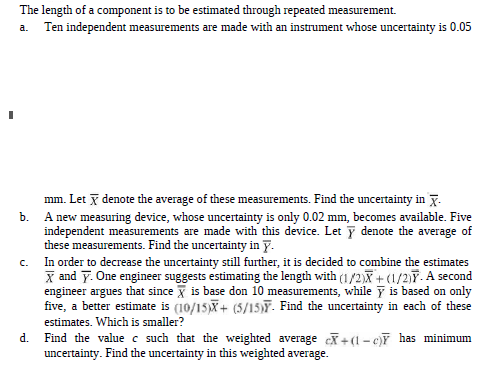The length of a component is to be estimated through repeated measurement. Ten independent measurements are made with an instrument whose uncertainty is 0.05 a. mm. Let denote the average of these measurements. Find the uncertainty in 7. b. A new measuring device, whose uncertainty is only 0.02 mm, becomes available. Five independent measurements are made with this device. Let y denote the average of these measurements. Find the uncertainty in y. In order to decrease the uncertainty still further, it is decided to combine the estimates X and y. One engineer suggests estimating the length with (1/2)X + (1/2)Y. A second engineer argues that since X is base don 10 measurements, while y is based on only five, a better estimate is (10/15)X+ (5/15)F. Find the uncertainty in each of these C. estimates. Which is smaller? Find the value c such that the weighted average c + (1- c)Y has minimum uncertainty. Find the uncertainty in this weighted average. d.
The length of a component is to be estimated through repeated measurement. Ten independent measurements are made with an instrument whose uncertainty is 0.05 a. mm. Let denote the average of these measurements. Find the uncertainty in 7. b. A new measuring device, whose uncertainty is only 0.02 mm, becomes available. Five independent measurements are made with this device. Let y denote the average of these measurements. Find the uncertainty in y. In order to decrease the uncertainty still further, it is decided to combine the estimates X and y. One engineer suggests estimating the length with (1/2)X + (1/2)Y. A second engineer argues that since X is base don 10 measurements, while y is based on only five, a better estimate is (10/15)X+ (5/15)F. Find the uncertainty in each of these C. estimates. Which is smaller? Find the value c such that the weighted average c + (1- c)Y has minimum uncertainty. Find the uncertainty in this weighted average. d.
Mathematics For Machine Technology
8th Edition
ISBN:9781337798310
Author:Peterson, John.
Publisher:Peterson, John.
Chapter31: Customary Vernier Calipers And Height Gages
Section: Chapter Questions
Problem 16A: The tables for Exercises 15 and 16 give the position of the zero graduation on the vernier scale in...
Related questions
Question
100%

Transcribed Image Text:The length of a component is to be estimated through repeated measurement.
Ten independent measurements are made with an instrument whose uncertainty is 0.05
a.
mm. Let denote the average of these measurements. Find the uncertainty in 7.
b. A new measuring device, whose uncertainty is only 0.02 mm, becomes available. Five
independent measurements are made with this device. Let y denote the average of
these measurements. Find the uncertainty in y.
In order to decrease the uncertainty still further, it is decided to combine the estimates
X and y. One engineer suggests estimating the length with (1/2)X + (1/2)Y. A second
engineer argues that since X is base don 10 measurements, while y is based on only
five, a better estimate is (10/15)X+ (5/15)F. Find the uncertainty in each of these
C.
estimates. Which is smaller?
Find the value c such that the weighted average c + (1- c)Y has minimum
uncertainty. Find the uncertainty in this weighted average.
d.
Expert Solution
This question has been solved!
Explore an expertly crafted, step-by-step solution for a thorough understanding of key concepts.
This is a popular solution!
Trending now
This is a popular solution!
Step by step
Solved in 4 steps

Recommended textbooks for you

Mathematics For Machine Technology
Advanced Math
ISBN:
9781337798310
Author:
Peterson, John.
Publisher:
Cengage Learning,

Algebra & Trigonometry with Analytic Geometry
Algebra
ISBN:
9781133382119
Author:
Swokowski
Publisher:
Cengage

Mathematics For Machine Technology
Advanced Math
ISBN:
9781337798310
Author:
Peterson, John.
Publisher:
Cengage Learning,

Algebra & Trigonometry with Analytic Geometry
Algebra
ISBN:
9781133382119
Author:
Swokowski
Publisher:
Cengage